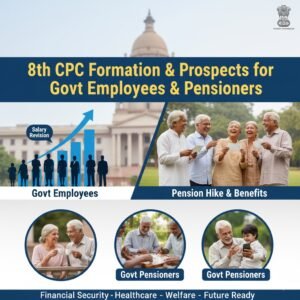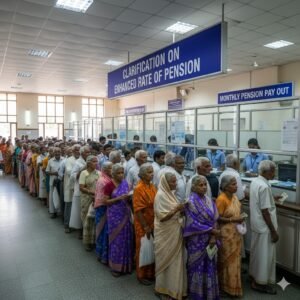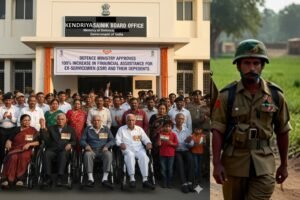The issue of additional pension benefits for Central Government pensioners has been a subject of significant discussion. In response to an unstarred question (No. 2991) raised in the Lok Sabha on March 19, 2025, the Ministry of Personnel, Public Grievances, and Pensions provided insights into the existing eligibility criteria, the rationale behind it, and the Government’s stance on suggested amendments.
Current Eligibility Criteria for Additional Pension Benefits
The Government, based on the recommendations of the 6th Central Pay Commission (CPC), has approved a structured increase in additional pension benefits as follows:
- 80 years: 20% additional pension
- 85 years: 30% additional pension
- 90 years: 40% additional pension
- 95 years: 50% additional pension
- 100 years: 100% additional pension
The key justification for these increments is that with increasing age, pensioners face greater financial burdens, especially concerning healthcare and other essential needs.
Proposal to Lower the Age Threshold to 65 Years
A recommendation by the Parliamentary Standing Committee on Pensioners’ Grievances suggested reducing the eligibility age for additional pension to 65 years. However, the Government, after thorough examination of the Committee’s 110th report (dated December 10, 2021), submitted an action taken report on June 6, 2022. The Committee, in its 120th report (dated December 8, 2022), noted that they do not wish to pursue this matter further for the time being.
Impact and Financial Implications
One of the critical concerns in extending pension benefits to a younger age group is the potential financial burden on the exchequer. The Government must balance welfare measures with fiscal sustainability, ensuring that the pension scheme remains viable in the long run.
Mechanisms to Ensure Timely Pension Disbursal
The pension system is structured to ensure that payments are made promptly. The additional pension is automatically credited to pensioners or family pensioners by the Pension Disbursing Authorities/Banks as soon as it becomes due. The Government has also issued guidelines to ensure transparency and punctuality in pension disbursal.
Addressing Inflation and Living Cost Adjustments
To combat the effects of inflation and rising living costs, pensioners receive Dearness Relief (DR), equivalent to the Dearness Allowance (DA) paid to Central Government employees. The DR is periodically revised to align with economic conditions, ensuring that pensioners’ financial stability is maintained.
While there have been discussions regarding reducing the eligibility age for additional pension benefits, the Government has currently opted not to pursue such changes. Instead, the focus remains on ensuring timely pension disbursal and protecting pensioners from inflationary pressures through Dearness Relief adjustments. The structured increment in pension benefits post-80 years remains a crucial support system for aging pensioners, addressing their increasing financial and healthcare needs.
- Complete Guide to AFD-I Entitlements Under CSD for Serving, Retired Defence Personnel & Defence Civilians (2025 Update)The Canteen Stores Department (CSD) provides a wide range of… Read more: Complete Guide to AFD-I Entitlements Under CSD for Serving, Retired Defence Personnel & Defence Civilians (2025 Update)
- Get Direct Support from ESM Info Club: A Dedicated Platform for the Welfare of Veterans and Their FamiliesThe ESM Info Club is a committed welfare initiative dedicated… Read more: Get Direct Support from ESM Info Club: A Dedicated Platform for the Welfare of Veterans and Their Families
- Convert Your Defence Salary Package Account to DSP Pension Account Today Just From Your HomeBenefits applicable to DSP Pension Account Holder Benefits under Pension… Read more: Convert Your Defence Salary Package Account to DSP Pension Account Today Just From Your Home
- Reemployed Exservicemen Must Submit this Certificate to PCDA (P) to Continue DR on PensionIt has been observed that deerness relief of some pensioners… Read more: Reemployed Exservicemen Must Submit this Certificate to PCDA (P) to Continue DR on Pension
- SPARSH will Deduct DR with Life Certificate ? Analysis of PCDA Circular No. 200 and Pension RegulationsRe-employment after military retirement is common among Junior Commissioned Officers… Read more: SPARSH will Deduct DR with Life Certificate ? Analysis of PCDA Circular No. 200 and Pension Regulations
- Intelligence Bureau (IB) MTS Recruitment 2025 – Complete DetailsThe Intelligence Bureau (IB), operating under the Ministry of Home… Read more: Intelligence Bureau (IB) MTS Recruitment 2025 – Complete Details
- Recruitment of Women Sports Athletes in Territorial Army (Home & Hearth) BattalionThe Territorial Army (TA) is initiating a special recruitment drive… Read more: Recruitment of Women Sports Athletes in Territorial Army (Home & Hearth) Battalion
- A Clear Concept of Roles and Responsibilities of Zila Sainik BoardA Detailed information for awareness of Ex-Servicemen Zila Sainik Boards… Read more: A Clear Concept of Roles and Responsibilities of Zila Sainik Board
- Exservicemen may apply for PMSS for Academic Year 2025–26A Comprehensive Guide for Eligible Students and Ex-Servicemen Families The… Read more: Exservicemen may apply for PMSS for Academic Year 2025–26
- India’s Defence Manufacturing on Display at the 44th IITFThe 44th India International Trade Fair (IITF) opens tomorrow, 14… Read more: India’s Defence Manufacturing on Display at the 44th IITF
- Indian Air Force Recruitment 2026 in Officers Cadre – AFCAT 01/2026 & NCC Special Entry (Courses Commencing January 2027)Indian Air Force (IAF) has announced recruitment for men and… Read more: Indian Air Force Recruitment 2026 in Officers Cadre – AFCAT 01/2026 & NCC Special Entry (Courses Commencing January 2027)
- Why 8th CPC Prospects for Highly Improving Pay & Pension of Central Government EmployeesThe Government of India has constituted the 8th Central Pay… Read more: Why 8th CPC Prospects for Highly Improving Pay & Pension of Central Government Employees
- Clarification on Enhanced Rate of Family Pension After Death Post-Retirement — Must Know for all pensionersThe Government of India’s Department of Pension & Pensioners’ Welfare… Read more: Clarification on Enhanced Rate of Family Pension After Death Post-Retirement — Must Know for all pensioners
- Job Fair 2025 for Ex-Servicemen : Organised by DGREmpowering Veterans with New Career Opportunities The Directorate General Resettlement… Read more: Job Fair 2025 for Ex-Servicemen : Organised by DGR
- Defense Ministry Approves 100% Increase in Financial Assistance for Ex-Servicemen (ESM) and Their DependentsGovt Welfare Schemes for Exservicemen On 15 October 2025, the… Read more: Defense Ministry Approves 100% Increase in Financial Assistance for Ex-Servicemen (ESM) and Their Dependents
- India-Mongolia Strategic Partnership Strengthened: Defence Minister Rajnath Singh Calls on Mongolian President KhurelsukhIntroduction and Core Outcome Raksha Mantri Shri Rajnath Singh called… Read more: India-Mongolia Strategic Partnership Strengthened: Defence Minister Rajnath Singh Calls on Mongolian President Khurelsukh
- Petty Officer Vs Havildar : Need to Re-designating Indian Army RanksNo more Humiliation of Army Ranks The rank structure of… Read more: Petty Officer Vs Havildar : Need to Re-designating Indian Army Ranks
- WB SSC Gp C and D Exam 2025 – Apply NowThe West Bengal Central School Service Commission (WBSSC) has announced… Read more: WB SSC Gp C and D Exam 2025 – Apply Now
- Strengthening India’s Defence Capabilities: Powering Modernisation Through Optimum Budget UtilisationPowering Modernisation Through Optimum Budget Utilisation India’s journey toward building… Read more: Strengthening India’s Defence Capabilities: Powering Modernisation Through Optimum Budget Utilisation

































